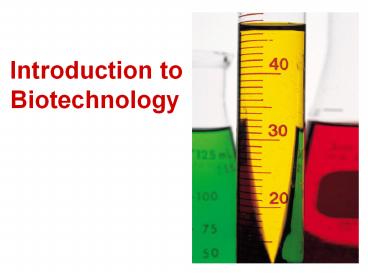Introduction to Biotechnology - PowerPoint PPT Presentation
1 / 32
Title:
Introduction to Biotechnology
Description:
Introduction to Biotechnology What is Biotechnology? Biotechnology is the manipulation of living organisms and organic material to serve human needs. – PowerPoint PPT presentation
Number of Views:574
Avg rating:3.0/5.0
Title: Introduction to Biotechnology
1
Introduction to Biotechnology
2
What is Biotechnology?
- Biotechnology is the manipulation of living
organisms and organic material to serve human
needs. - Examples
- Yeast in bread making and alcohol production
- Use of beneficial bacteria (penicillin) to kill
harmful organisms - Cloning of plants and animals
- Artificial insemination
3
Biotechnology Industry
- Research is conducted by small companies, large
corporations, and public universities. - How might thistechnology impactthe economy?
4
Biotechnology Industry
- Focuses on a variety of research areas including
- Health/medicine
- Food science
- Environmental science
- Agriscience
5
Impact of Biotechnology
- Genetically modified organisms (GMOs) are
consumed by millions of people (especially
Americans) EVERY DAY. - Almost 56 of all soybean plantings worldwide are
genetically engineered (much higher in the US)
6
Impact of Biotechnology
- Genetically modified crops were produced on more
than 167 million acres in 18 countries in 2003, a
15 increase from 2002 - The US was the largest single producer with more
than 60 of the total acreage in production.
7
Impact of Biotechnology
- The NC Biotechnology Center predicts that the
biotechnology industry in the state will
contribute more than 25 billion in annual income
each year within the next 25 years.
8
Historical Development of Biotechnolgoy
9
1750 B.C.
- Origins of biotechnology emerge in methods of
food production and plant and animal breeding - Use of bacteria to produce cheese (food
preservation) - Use of natural enzymes in yogurt
- Use of yeast to produce bread
- Use of fermentation for producing wine and beer
10
1869
- DNA is discovered in trout by a German man named
Miescher
11
1919
- The word biotechnology is first used by a
Hungarian agricultural engineer.
12
1940s-1950s
- Widespread work is undertaken to investigate the
structure and function of DNA
13
1980
- The U.S. Supreme Court approves the patenting of
genetically altered organisms.
14
1980s-1990s
- A variety of GMOs and biotechnology techniques
are introduced in fields from agriculture to
medicine - Recombinant DNA technology-extracts DNA from one
organism for use in another, allowing more rapid
and specific improvements in plants and animals - Plant Tissue Culture-gains widespread acceptance
as a method to quickly and cheaply produce
genetically identical plants
15
1990s
- First transgenic organisms (GMOs) are introduced
in widespread agricultural production,
particularly in the area of crops. - corn and soybeans are introduced offering
natural insect resistance by the introduction
of a gene from the bacterium Baccillus
thuringensis
16
1997
- Dolly is the first animal cloned from diploid
cells is produced in Scotland
17
Late 1990s-Early 2000s
- Human cloning is outlawed in the U.S. and the
first concerns over the use of human stem cells
in research begin to arise.
18
Biotechnology and Agriscience
19
Biotechnology and Agriscience
- There has been increased activity and research
between different agricultural areas with common
research techniques and goals - Plant Science
- Animal Science
- Environmental Science
- Health/Agri-Medicine
20
Plant Science
- Wide scale production of transgenic plants
impacting horticulture
21
Animal Science
- Increased use of methods of in vitro
fertilization and artificial insemination improve
selected breed programs
22
Environmental Science
- Use of biotechnology techniques in environmental
science for cleaning contaminants and protecting
endangered species - Bioremediation-use of natural organisms to clean
contaminants
23
Health/Agri-medicine
- the creation of plants and animals capable of
producing medical substances
24
Health/Agri-medicine
- DNA analysis/paternity testing has emerged as a
technique to test the genetic ancestry of animals
25
Problems with Biotechnology in Agriculture
26
Problems with Biotechnology
- Transfer of genes found in transgenic organisms
to natural populations. - Terminator genes have been used to minimize this
risk
27
Problems with Biotechnology
- Unexpected impacts of genetically modified
organisms and biotechnology processes on other
organisms and the environment
28
Problems with Biotechnology
- Expense of the utilization of many biotechnology
techniques - Cost of producing transgenic animals (There are
transgenic fish, but no livestock yet.)
29
Problems with Biotechnology
- Concerns over the safety and ethics of
incorporating GMOs into food for human
consumption
30
Problems with Biotechnology
- Lack of education among both consumers and
producers concerning biotechnology processes and
products
31
Biotechnology Terms
32
Biotechnology Terms
- Use what you have learned to define the following
terms - Cloning
- Deoxyribonucleic acid
- Genetics
- Genetic Engineering
- GMO
- Transgenic Organism































